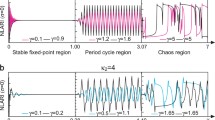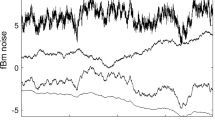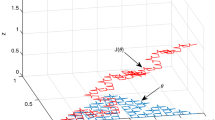Abstract
Many biological systems having one or more characteristics that remain constant over a wide range of scales may be considered self-similar or fractal. Geometrical and functional overview of the ventricular conduction system of the heart reveals that it shares structures common to a tree with repeatedly bifurcating “branches,” decreasing in length with each generation. This system may further simplify by assuming that the bifurcating and decreasing process is the same at any generation, that is, the shortening factor and the angle of bifurcation are the same for each generation. Under these assumptions, the conduction system can be described as a fractal tree. A model of the heart's ventricles which consists of muscle cells and a fractal conduction system is described. The model is activated and the dipole potential generated by adjacent activated and resting cells is calculated to obtain a QRS complex. Analysis of the frequency spectrum of the QRS complex reveals that the simulated waveforms show an enhancement in the high frequency components as generations are added to the conduction system. It was also found that the QRS complex shows a form of an inverse power law, which was predicted by the fractal depolarization hypothesis, with a highly correlated straight line for a log-power versus log frequency plot with a slope of approximately −4. Similar results were obtained using real QRS data from healthy subjects.
Similar content being viewed by others
References
Abboud, S.; Cohen, R.J.; Selwyn, A.; Sadeh, D.; Friedman, P.L. Detection of transient myocardial ischemia by computer analysis of standard and signal averaged high frequency electrocardiogram in patients undergoing percutaneous transluminal coronary angioplasty. Circulation 76(3):585–596; 1987.
Abboud, S.; Berenfeld, O.; Sadeh, D. Simulation of high-resolution QRS complex using a ventricular model with a fractal conduction system — Effects of ischemia on high-frequency QRS potentials. Circ. Res. 68(6):1751–1760; 1991.
Aoki, M.; Okamoto, Y.; Musha, T.; Harumi, K.I. Three-dimensional simulation of the ventricular depolarization and repolarization process and body surface potentials; normal heart and bundle branch block. IEEE Trans. Biomed. Eng. BME 34(6):454–462; 1987.
Cuffin, B.N.; Geselowitz, D.B. Studies of the electrocardiogram using realistic cardiac and torso models. IEEE Trans. Biomed. Eng. BME 24(3):242–252; 1977.
Detweiler, D.K. Circulation. In: Brobeck, J.R., ed. Best and Taylor's physiological basis of medical practice. 10th ed. Baltimore: The Williams and Williams Company; 1979: pp. 47–88.
Eberhart, R.C. Chaos theory for the biomedical engineer. IEEE Eng. Med. Biol. Mag. 8(3):41–45; 1989.
Geselowitz, D.B. On the theory of the electrocardiogram. Proc. of the IEEE 77(6):857–876; 1989.
Goldberger, A.L.; Bhargava, V.; West, B.J.; Mandell, A.J. On the mechanism of cardiac electrical stability; the fractal hypothesis. Biophys. J. 48:525–528; 1985.
Goldberger, A.L.; West, B.J. Fractals in physiology and medicine. The Yale Journal of Biology and Medicine 60: 421–435; 1987.
Malik, M.; Cochrane, T.; Camm, A.J. Computer simulation of the cardiac conduction system. Comput. Biomed. Res. 16:454–468; 1983.
Massing, G.K.; James, T.N. Anatomical configuration of the his bundle and bundle branches in the human heart. Circulation 53(4):609–621; 1976.
Plonsey, R. Bioelectric phenomena, New York: McGraw Hill; 1969: pp. 1–22, 202–233, 324–332.
Rudy, Y.; Plonsey, R. A comparison of volume conductor and source geometry effects on body surface and epicardial potentials. Circ. Res. 46(2):283–291; 1980.
Scher, A.M. Electrocardiogram. In: Ruch, T.C.; Patton, H.D. eds. Physiology and biophysics II. Philadelphia: W.B. Sounders; 1974; pp. 65–101.
Thakor, N.V.; Eisenman, L.N. Three-dimensional computer model of the heart: Fibrillation induced by extrastimulation. Comput. Biomed. Res. 22:532–545; 1989.
Author information
Authors and Affiliations
Rights and permissions
About this article
Cite this article
Berenfeld, O., Sadeh, D. & Abboud, S. Modeling of the heart's ventricular conduction system using fractal geometry: Spectral analysis of the QRS complex. Ann Biomed Eng 21, 125–134 (1993). https://doi.org/10.1007/BF02367608
Received:
Revised:
Issue Date:
DOI: https://doi.org/10.1007/BF02367608




